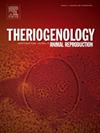利用羊膜细胞作为核供体,通过体细胞核移植生产第二代绵羊克隆。
IF 2.4
2区 农林科学
Q3 REPRODUCTIVE BIOLOGY
引用次数: 0
摘要
体细胞核移植(SCNT)改变了动物基因改良、模型生产中的基因编辑、异种移植和濒危物种保护工作。然而,SCNT 衍生的胚胎偶尔会出现发育异常,胚胎移植后的流产率也很高。基因编辑的胎儿可能会出现先天缺陷,导致存活率下降。正确选择核供体细胞对体细胞克隆的成功至关重要。成纤维细胞是最常用的细胞,但其快速增殖会增加基因突变的风险,影响胚胎的发育和生产。相反,羊膜细胞的增殖速度较慢,可降低培养过程中的基因突变风险。因此,羊膜细胞是比成纤维细胞更好的 SCNT 候选细胞,因为它们具有基因组稳定性、低致瘤和致畸风险、低免疫原性、高分化潜能、易获得性和较少伦理问题。来自第一代基因编辑动物的细胞具有稳定的基因结构,对基因改变和人工修饰的敏感性降低,与天然细胞非常相似,与 SCNT 程序的兼容性增强。用基因编辑绵羊胎儿的羊膜细胞作为 SCNT 的核供体细胞,成功地克隆了三只健康的第二代基因编辑绵羊。与编辑成纤维细胞相比,使用羊膜细胞作为 SCNT 的核供体细胞不会显著改变胚胎裂解率、囊胚形成或胎儿出生率(p > 0.05)。然而,胎儿存活率明显高于编辑成纤维细胞(p本文章由计算机程序翻译,如有差异,请以英文原文为准。
Production of second-generation sheep clones via somatic cell nuclear transfer using amniotic cells as nuclear donors
Somatic Cell Nuclear Transfer (SCNT) has transformed animal genetic improvement, gene-editing in model production, xenotransplantation, and conservation efforts for endangered species. However, SCNT-derived embryos occasionally display developmental abnormalities, and following embryo transfer, the miscarriage rate is high. Gene-edited fetuses may experience birth defects, resulting in decreased survival rates. Correct selection of nuclear donor cells is essential for the success of somatic cell cloning. Fibroblasts are the most commonly used cells, but their rapid proliferation increases the risk of genetic mutation, impairing embryo development and production. Conversely, amniotic cells have slower proliferation rates, decreasing the mutation risk during cultivation. Amniotic cells are thus better SCNT candidates than fibroblasts because they offer genomic stability, low tumorigenic and teratogenic risks, reduced immunogenicity, high differentiation potential, ease of accessibility, and fewer ethical concerns. Cells derived from first-generation gene-edited animals exhibit stable genetic structures, reduced susceptibility to genetic alterations and artificial modifications, closely resembling natural cells, and enhanced compatibility with SCNT procedures. Amniotic cells derived from gene-edited sheep fetuses used as nuclear donor cells for SCNT successfully recloned three healthy second-generation gene-edited sheep. Using amniotic cells as nuclear donor cells for SCNT did not significantly alter embryo cleavage rates, blastocyst formation, or fetal birth compared to edited fibroblasts (p > 0.05). However, fetal survival rates were significantly higher than edited fibroblasts (p < 0.05). The results support the potential of amniotic cells as SCNT alternatives, suggesting a promising strategy to improve gene-edited fetus survival rates using first-generation gene-edited sheep-derived amniotic cells.
求助全文
通过发布文献求助,成功后即可免费获取论文全文。
去求助
来源期刊

Theriogenology
农林科学-生殖生物学
CiteScore
5.50
自引率
14.30%
发文量
387
审稿时长
72 days
期刊介绍:
Theriogenology provides an international forum for researchers, clinicians, and industry professionals in animal reproductive biology. This acclaimed journal publishes articles on a wide range of topics in reproductive and developmental biology, of domestic mammal, avian, and aquatic species as well as wild species which are the object of veterinary care in research or conservation programs.
 求助内容:
求助内容: 应助结果提醒方式:
应助结果提醒方式:


